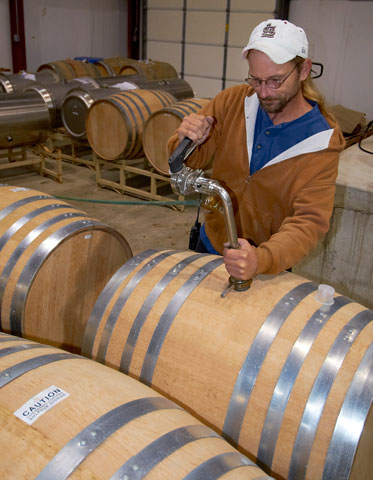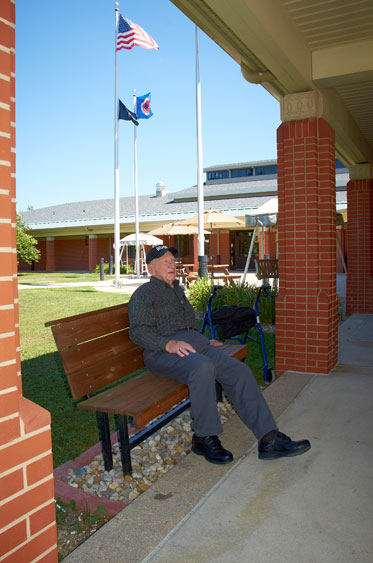Community Profile: Plentiful Green Space along Interstate Drives Economy of Tiny Missouri Town
Photo Gallery | Article
Photo Gallery - St. James/Phelps County, Mo.

St. James had what Wal-Mart wanted—200 flat, buildable acres near an interstate interchange. In return, the town got 1,000 jobs. Photo by Steve Smith Studios

Ken Wilkinson assembles a vacuum cleaner at the Tacony Corp. plant in St. James. Tacony, based in St. Louis, moved its manufacturing from Taiwan to the U.S. because it wasn’t happy with the quality of the work or the product development expertise it had found overseas. Photo by Susan C. Thomson

Justin Davis assembles vacuums, clearly marked that they are made in the United States. Photo by Susan C. Thomson

Tom Gasko relaxes at Tacony’s vacuum cleaner museum, where he is the curator. Room after room of vacuums—some at least 100 years old—help to draw tourists to St. James. Gasko, a longtime collector, donated the vacuums. Photo by Steve Smith Studios

The vacuum museum contains room after room of cleaners, some more than 100 years old. The museum, part of the Tacony Corp., is another tourist draw for St. James. Photo by Steve Smith Studios

At St. James Winery, Jimmy Bailey (left) and Trevor Metzger transfer “must” to tanks for the first pressing of a batch of grapes. Photo by Steve Smith Studios

In the tasting room at St. James Winery, Maribeth Wronkiewicz prepares to serve customers. St. James Winery is the largest of about 100 wineries in the state and one of about five in the St. James area. To draw tourists to the St. James area, several wine and grape-themed festivals are held every year. Photo by Steve Smith Studios

Jimmy Bailey checks on a barrel of wine at St. James Winery. Photo by Steve Smith Studios

The city’s library and new swimming pool are among the legacies of a private philanthropy, the James Foundation, which was established by a descendant of the family that gave the town its name. Photo by Steve Smith Studios

The city’s library and new swimming pool are among the legacies of a private philanthropy, the James Foundation, which was established by a descendant of the family that gave the town its name. Photo by Susan C. Thomson

Buel F. Leuthen enjoys the fresh air at the Missouri Veterans Home in St. James, one of the nonprofit employers that have kept the economy on an even keel over the decades. Photo by Steve Smith Studios
Interstate 44 runs more than 600 miles across the center of the country, between St. Louis and Wichita Falls, Texas—and right through St. James, Mo. The tiny town has parlayed the thoroughfare that divides it and the acres of developable land nearby into its biggest economic assets.
For Tacony Corp., one of the initial attractions to St. James was its location just 80 miles down I-44 from the company's corporate headquarters in suburban St. Louis, says the president and chief operating officer, Bill Hinderer. Bucking a trend, the privately held company moved manufacturing to the United States from Asia. Hinderer says Tacony was unhappy with the quality of the vacuum cleaners it was making in Taiwan and with the engineering expertise there for product development.
To help make the move possible, the city of St. James secured $153,240 in state and federal grants and added $50,000 out of its own coffers to upgrade and improve street access to a vacant, city-owned building. Tacony started out there in 1997, with 30 employees. It now has five times that number.
The interstate worked again in the city's favor when Wal-Mart was scouting a 100-mile stretch of I-44 for a site for a regional distribution center. The company found in St. James exactly what it had been seeking—200 flat, buildable acres near an interchange.
In 2001, less than a mile from the intersection of I-44 and state Highway 68, Wal-Mart opened its center. Hiring 1,000 people right off the bat, Wal-Mart immediately became, by far, St. James' largest employer ever. State and federal grants totaling $182,500 paid for utilities and a new access road. The city issued $59 million in 20-year industrial revenue bonds to buy the land and to build and equip the 1.2-million-square-foot center. The company is leasing it all for an amount equal to the principal and interest and will become the owner when the bonds are paid off.
From its investments in the two companies, the city's payoff has been hundreds of jobs—secure and with competitive wages and benefits, says Bob Wilson, executive vice president of Phelps County Bank and a long-time member of St. James' Industrial Development Authority (IDA). "We now have younger citizens staying in the area to work and raise a family," he says.
The new corporate jobs have also plumped up the cushion against economic jolts, a cushion that has long been provided by the city's substantial base of steady public and nonprofit employers.
One of these is the private social service agency originally called Boys Town, a St. James mainstay since its 1949 founding as a home for troubled boys. It went on to serve girls as well, change its name accordingly and offer outpatient care. Since merging in 2009 with an agency in St. Louis, it has moved its headquarters there while keeping its 442-acre St. James campus.
The Missouri Veterans Home, one of seven the state operates, has been a St. James stalwart since the home's founding in 1896. Fifteen years ago, it moved into a new
150-bed building on the same park-like, 40-acre site.
The city also gets a sustaining economic lift from a private philanthropy, the James Foundation. Lucy Wortham James (1880-1938), a descendant of the family that established an ironworks in the area in 1826 and gave the town its name, set it up for her hometown's benefit. Annual income of about $1.7 million from the trust's investments maintains the city's park, cemetery and library, as well as the 1,860-acre Maramec Spring Park, a few miles southeast of town. The foundation also sets aside $5,000 a year for grants to various civic betterment projects. It deeded 2.25 park acres to the city for the $2 million swimming pool it opened this past summer.
The foundation has been a community cornerstone, "a critical element for stability
and beautification over the years," says Peter Hofherr, chief executive of St. James Winery.
His family-owned business is the largest of the state's approximately 100 wineries, with sales of about 500,000 gallons last year, a 9 percent increase from 2009. St. James is also home to Meramec Vineyards, and there are three other wineries within a few miles.
Capitalizing on the local wine culture, the St. James Chamber of Commerce underwrites four wine and grape-themed festivals a year, three of them new since 2009. Attendance increases at each of the two- and three-day festivals every year, according to the chamber's president, Renee Ridling. "I think our future in St. James is going to be enhanced by tourism growth," she says. To better promote it, the chamber took over the city's tourist information center near I-44 and expanded its hours in mid-2011.
Around the same time, the city acquired yet another tourist attraction when Tacony opened a vacuum cleaner museum. The display of machines, dating back to the early 1900s, is in the company's present plant in the city's 121-acre industrial park. To accommodate the growing company's move from its original location, the city gave it 11.4 park acres valued at $228,000.
The company has expanded its new building three times to a total of 200,000 square feet as it boosted production and added jobs, most recently 35 of them in 2009 and 2010, Hinderer says. Along the way, the city has arranged $518,849 in community development block grants, which were used to build a new water storage tank for the plant and to pave and light an access street.
Tacony is the only full-line vacuum cleaner plant left in the U.S., producing the high-end Riccar and Simplicity brands, sold through dealers. With the move stateside, the company has "succeeded in making higher quality products, better engineered for the U.S. market but at higher costs," Hinderer says. But the move has been worth it, he insists.
Tacony is the largest tenant in the park, which is home to 10 businesses, including two machine shops, a cabinet manufacturer, a concrete block maker, the offices of a trucking company and a new high-tech startup.
The last is Product Innovation and Engineering LLC, which sells unique software for high-speed manufacturing. The software was developed at the National Science Foundation's Small Business Technology Transfer program at Missouri University of Science and Technology (MS&T) in Rolla, Mo. The software was based on research by Frank Liou, a professor there. The eight-employee company, now co-owned by Liou and his wife, Lisa, put up a 3,500-square-foot building in the industrial park and moved there in July. Lisa Liou is president.
The company took advantage of the city's offer of 1.5 free acres in the industrial park for every eight jobs created there. The offer stands, and about half of the 30-year-old park remains available.
For years, the city hoped to find a single taker for one 40-acre parcel there, says Butch Tucker, president of the Industrial Development Authority. That no longer seems realistic to him. Nor does he expect more developments on a Wal-Mart scale or, given the current international business climate, more corporate repatriates like Tacony.
Hinderer agrees. Although reaction to the company's move has been overwhelmingly positive, he says, he knows of no others that have followed suit as a result.
While receptive to prospects of any size, the IDA is mostly counting on smaller manufacturing, wholesale and retail enterprises, Tucker says.
"Home runs [like Tacony and Wal-Mart] are few and far between," says Brad Frazier, the Wal-Mart center's civic-minded general manager. "What I'd like to see is a group of smaller businesses"—singles, in baseball terms. As possibilities, he and others mention more spin-offs from MS&T, which is just 10 miles away.
Community leaders are just as eager for more commercial development. In the city's local customer base, they count not only residents but also Wal-Mart's 1,000 employees, drawn from as far as 50 miles away. These people are already shopping at local gas stations and convenience stores, says Mayor Dennis Wilson. "Additional retail would be an enticement to these folks when they get off shift to stop and shop more," he says. It would also provide the city with much-needed additional sales tax revenue, says Bob Wilson, the banker and the mayor's brother.
Toward that end, the city is promoting one 13-acre parcel, about a block from the interstate, with a half-empty strip shopping center on it. Candace Connell, the city's community development director, envisions a mixed-used development, possibly including a grocery store, farm supply store, discount store, and hotel or motel. The city has signaled its willingness to offer tax-increment financing to a developer.
In all, the mayor estimates that there are at least 100 acres of developable land left within the city limits, most of it "fronting or just a few blocks off the interstate."
St. James/Phelps County, Mo., by the numbers
| POPULATION FOR CITY/COUNTY |
4,216/45,156 (1)
|
| LABOR FORCE |
NA/22,300 (2)
|
| UNEMPLOYMENT RATE |
NA/7 percent (2)
|
| PER CAPITA PERSONAL INCOME |
NA/$39,768 (3)
|
| (1) U.S. Bureau of the Census, 2010 census | |
| (2) BLS/HAVER, July 2011, seasonally adjusted | |
| (3) BEA/HAVER, 2009 | |
| Largest Employers | |
| Wal-Mart Distribution Center |
1,000
|
| Boys & Girls Town of Missouri |
280
|
| St. James Public Schools |
225(4)
|
| Missouri Veterans Home |
185
|
| Tacony Corp. |
150
|
| SOURCE: Self-reported (4) Includes five part-time |
|
Views expressed in Regional Economist are not necessarily those of the St. Louis Fed or Federal Reserve System.
For the latest insights from our economists and other St. Louis Fed experts, visit On the Economy and subscribe.
Email Us

